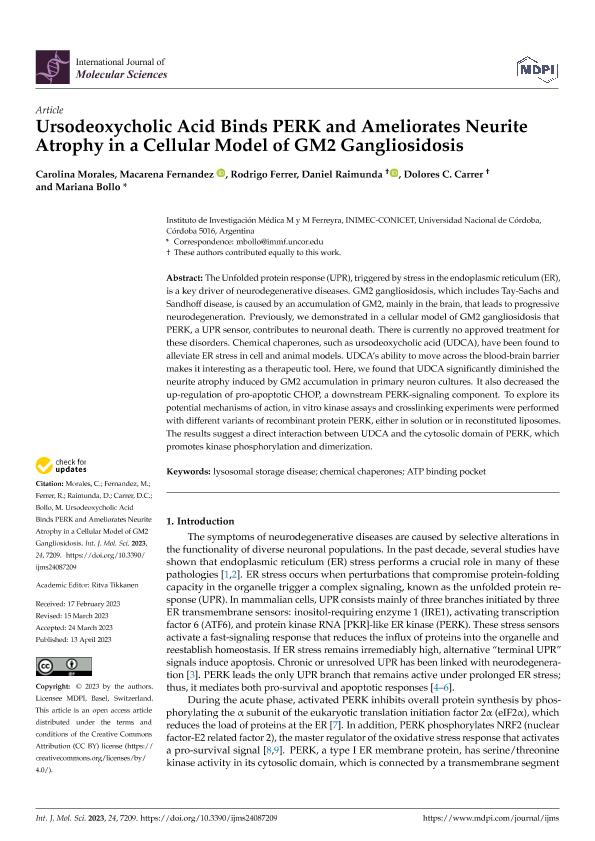Artículo
Ursodeoxycholic Acid Binds PERK and Ameliorates Neurite Atrophy in a Cellular Model of GM2 Gangliosidosis
Morales, Carolina Laura ; Fernández, Macarena
; Fernández, Macarena ; Ferrer, Rodrigo; Raimunda, Daniel Cesar
; Ferrer, Rodrigo; Raimunda, Daniel Cesar ; Carrer, Dolores Catalina
; Carrer, Dolores Catalina ; Bollo, Mariana Ines
; Bollo, Mariana Ines
 ; Fernández, Macarena
; Fernández, Macarena ; Ferrer, Rodrigo; Raimunda, Daniel Cesar
; Ferrer, Rodrigo; Raimunda, Daniel Cesar ; Carrer, Dolores Catalina
; Carrer, Dolores Catalina ; Bollo, Mariana Ines
; Bollo, Mariana Ines
Fecha de publicación:
03/2023
Editorial:
Molecular Diversity Preservation International
Revista:
International Journal of Molecular Sciences
ISSN:
1422-0067
Idioma:
Inglés
Tipo de recurso:
Artículo publicado
Clasificación temática:
Resumen
The Unfolded protein response (UPR),triggered by stress in the endoplasmic reticulum (ER), is a key driver ofneurodegenerative diseases. GM2 gangliosidosis, which includes Tay-Sachs andSandhoff disease, is caused by an accumulation of GM2 mainly in the brain thatleads to progressive neurodegeneration. Previously, we demonstrated in acellular model of GM2 gangliosidosis that PERK, a UPR sensor, contributes toneuronal death. There is currently no approved treatment for these disorders.Chemical chaperones like ursodeoxycholic acid (UDCA) have been found toalleviate ER stress in cell and animal models. UDCA’s ability to move acrossthe blood- brain barrier makes it interesting as a therapeutic tool. Here, wefound that UDCA significantly diminished the neurite atrophy induced by GM2accumulation in primary neuron cultures. It also decreased the up-regulation ofpro-apoptotic CHOP, a downstream PERK-signaling component. To explore itspotential mechanisms of action, in vitro kinase assays and crosslinking experimentswere performed with different variants of recombinant protein PERK, either insolution or in reconstituted liposomes. The results suggest a directinteraction between UDCA and the cytosolic domain of PERK, which promoteskinase phosphorylation and dimerization.
Palabras clave:
LYSOSOMAL STORAGE DISEASE
,
CHEMICAL CHAPERONES
,
ATP BINDING POCKET
Archivos asociados
Licencia
Identificadores
Colecciones
Articulos(INIMEC - CONICET)
Articulos de INSTITUTO DE INV. MEDICAS MERCEDES Y MARTIN FERREYRA
Articulos de INSTITUTO DE INV. MEDICAS MERCEDES Y MARTIN FERREYRA
Citación
Morales, Carolina Laura; Fernández, Macarena; Ferrer, Rodrigo; Raimunda, Daniel Cesar; Carrer, Dolores Catalina; et al.; Ursodeoxycholic Acid Binds PERK and Ameliorates Neurite Atrophy in a Cellular Model of GM2 Gangliosidosis; Molecular Diversity Preservation International; International Journal of Molecular Sciences; 24; 8; 3-2023; 1-15
Compartir
Altmétricas



